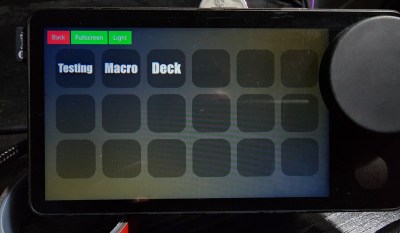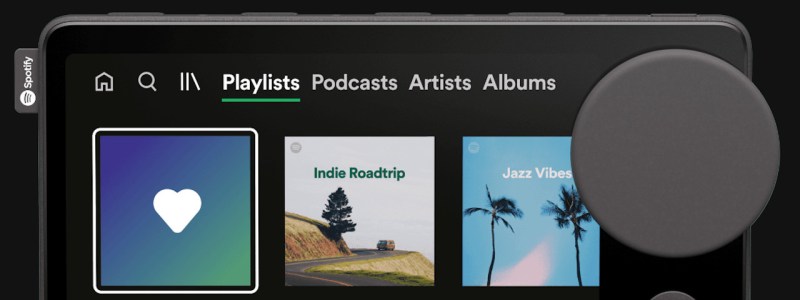If you haven’t heard by now, Spotify is shutting down support for their “Car Thing” on December 9th of this year. Once that happens the automotive media player will officially be useless, with users being advised to literally throw them in the trash come December 10th. Call it an early Christmas present from your friends at the multi-billion dollar streaming company.
Surely the hardware hacking community can do a bit better than that. As it turns out, there’s actually been a fair amount of hacking and research done on the Car Thing, it’s just that most of it happened a couple years back when the device first hit the market. Things stagnated a bit in the intervening years, but now that the clock is ticking, there’s far more interest in cracking open the gadget and seeing what else we can do with it.

If you’re more into the step-by-step approach, security researcher [Nolen Johnson] did a write-up about getting access to the Car Thing’s internal Linux system back in 2022 that’s certainly worth a look. As you’d imagine, there’s also a few YouTube videos out there that walk the viewer through gaining access to the hardware. This one from [Dinosaur Talks Tech] not only provides a good overview of how to get into the system, but covers flashing modified versions of the stock firmware to unlock various features and tweaking the internal Linux OS.
Interestingly enough, while we’ve seen plenty of homebrew hardware players for Spotify over the years, this is the first time the Car Thing has ever crossed our path. Something tells us though that this isn’t the last time we’ll hear about this forlorn Linux gadget.















Doom. Obvs.
i was thinking a handheld for racing games. but doom works.
Or Tetris
Nope. It’s not hacked until it can boot NetBSD. ;)
Looks like the Car Thing would make a fantastic HomeAsssistant wall mounted controller. Clickable dial could be dedicated to light control, with the touchscreen for info display and other controls.
This was my first thought, too. I love tactile controls, and the clickable dial would be a fun interface option. I could also see it being used as speaker volume control.
It’s so unfortunate that these sorts of projects have as quick of a lifecycle as this – $90 device launched 2021, on sale for a year, and then will be bricked at the end of 2024, with a recommendation that they be thrown in the trash. The best case scenario with this sort of quick end of life would be for the company to open source the hardware and firmware so that it can have a more vibrant second life. These sorts of projects are a solid alternative, but are a band-aid at best.
Christina Warren suggested earlier this week that it might have come down to font licensing:
https://youtu.be/-coQ-PTrDh8?t=9392
Which would be tragic, and IMO kind of embarrassing.
“That is the lamest thing I have ever heard, and I used to work in private equity”
It’s a Red Queen’s Race with every internet enabled device, because the service running in the cloud in the background is constantly mutating and the hardware is quickly becoming obsolete or even unable to work with new protocols, platforms, encryption and security etc…
Or if hacking isn’t your thing you could just sue…
https://www.musicbusinessworldwide.com/spotify-hit-with-class-action-lawsuit-over-discontinued-car-thing-device/
“The goal of our Car Thing exploration in the US was to learn more about how people listen in the car. …. and now it’s time to say goodbye to the devices entirely”
Sure sounds like: “We got you to pay for us doing some market research”
Only making it for less than 6 months will certainly help cement that impression in court I imagine.
“Launched in 2021 and … available…the following year, … Spotify announced it would stop making Car Thing in July 2022”
Make into a cheaper stream deck.
Uh… The car thing would be lucky to be able to emulate N64. A far cry from a “cheaper steam deck”
Check again, they said stream deck, a device from Elgato that is basically just some programmable buttons with displays, meant to be used as a macro pad for streamers.
They said “stream deck”, not “steam deck”. Obviously nobody is going to be playing video games on this thing.
Give me Pong and I’ll play on it all day long!
I believe they were suggesting making a diy version of the elgato stream deck, a computer accessory that gives you a number of reprogrammable buttons. The implication being that a touch screen with clickable dial would be good for the purpose.
I have to admit that would be a good use of the device if you’ve already got one. But given that stream decks range from 89 – 200 depending on features, I’m not confident it’d be a great investment to get a car thing with the hopes of rigging up a diy stream deck.
“stream” not “steam”.
As in parasocial breeding ground, not handheld device primarily meant for games.
Louis Rossmann has a pretty good rant about this on his youtube channel, the trouble is as soon as you allow for devices to be manufactured as cloud dependent, the buyer of the device ends up not as its owner but as its slave. “Smart” technologies connected to corporate servers never end up well for the buyers, see : https://dailysceptic.org/2023/09/27/the-coming-tyranny-of-smart-technology-is-worse-than-you-think-but-there-is-hope/
But in this case, thank heavens for the hackers who found ways in to this so it can be repurposed as a customised human interface device (and seemingly a pretty pleasant on in potential versatility) running a linux OS which respects your freedom. Well done to them all.
And thanks to Hackaday for sharing the links! I have a Car thing, saw the news, and my first thought was…I bet Hackaday will a) not be happy with Spotify, and b) find a better solution than “throw in trash”
I stay far away from “cloud” based devices. I have seen time and time again that a piece of hardware reliant on the “cloud” ends up being discontinued earlier than thought.
They need to make a “Plan B” for these devices. Either open source it, or release a final update that allows you to use basic functionality offline.
Makes my hacker heart jump, but my eco conscious heart bleed…
An SD card and an old phone are more useful as a media player. Spotify consumers are so passive as to buy into an ecosystem that doesn’t even pay actual musicians and artists. I hope the company goes the same way as their devices.
So…. a RPi Zero, modestly sized touchscreen and an encoder wheel with a button? Seems doable for less than $90. I guess if you already have one, you can save it from a landfill at least.
Does it have the facilities to become an Android or at least an ipod by hacking it it would be awesome i would just buy it cause it looks like a newer ipod